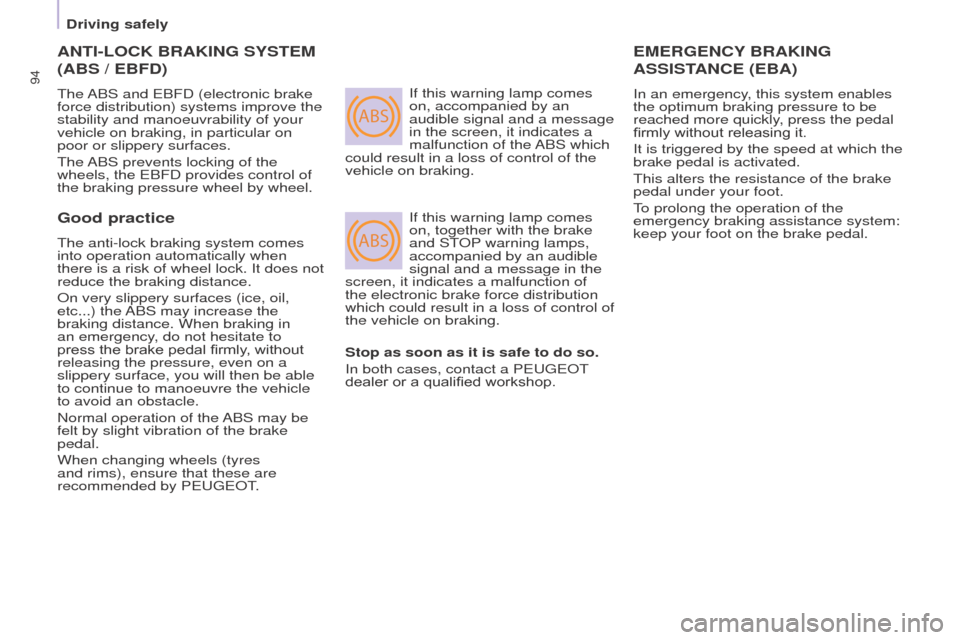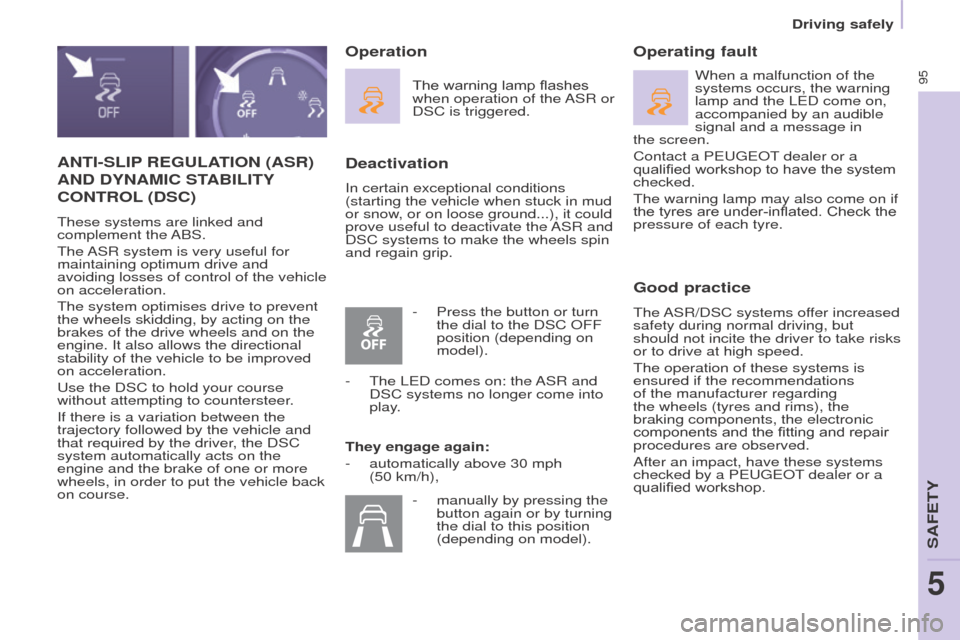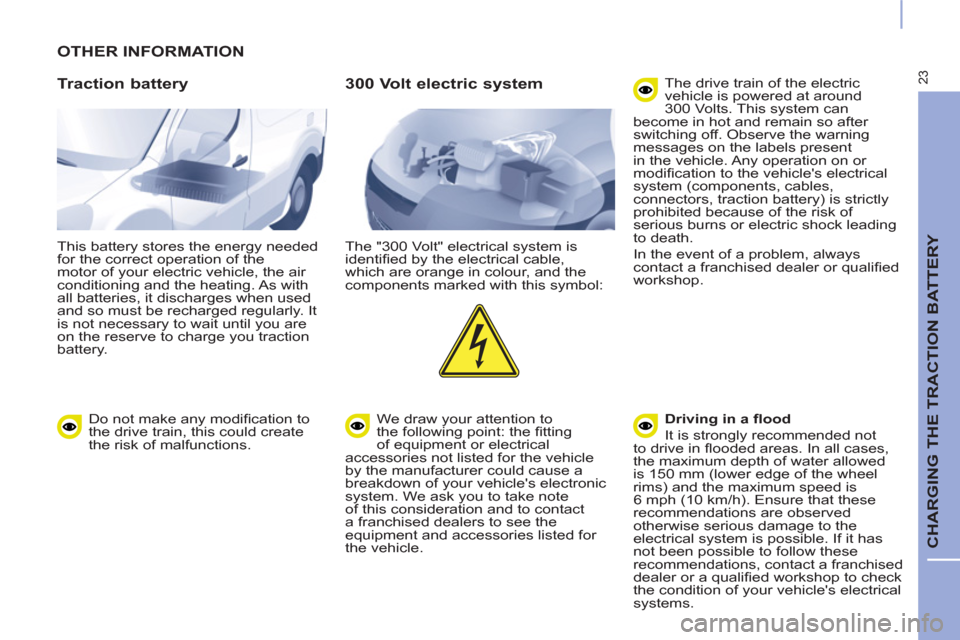2015 Peugeot Partner rims
[x] Cancel search: rimsPage 96 of 292

ABS
ABS
94
Partner-2-VU_en_Chap05_Securite_ed01-2015
ANTI-LOCK BRAKING SYSTEM
(ABS / EBFD)
The ABS and EBFD (electronic brake
force distribution) systems improve the
stability and manoeuvrability of your
vehicle on braking, in particular on
poor or slippery surfaces.
The ABS prevents locking of the
wheels, the EBFD provides control of
the braking pressure wheel by wheel. If this warning lamp comes
on, accompanied by an
audible signal and a message
in the screen, it indicates a
malfunction of the ABS which
could result in a loss of control of the
vehicle on braking.
If this warning lamp comes
on, together with the brake
and STOP warning lamps,
accompanied by an audible
signal and a message in the
screen, it indicates a malfunction of
the electronic brake force distribution
which could result in a loss of control of
the vehicle on braking.
EMERGENCY BRAKING
ASSIST
ANCE (EBA)
In an emergency, this system enables
the optimum braking pressure to be
reached more quickly, press the pedal
firmly without releasing it.
It is triggered by the speed at which the
brake pedal is activated.
This alters the resistance of the brake
pedal under your foot.
To prolong the operation of the
emergency braking assistance system:
keep your foot on the brake pedal.
Good practice
The anti-lock braking system comes
into operation automatically when
there is a risk of wheel lock. It does not
reduce the braking distance.
On very slippery surfaces (ice, oil,
etc...) the ABS may increase the
braking distance. When braking in
an emergency, do not hesitate to
press the brake pedal firmly, without
releasing the pressure, even on a
slippery surface, you will then be able
to continue to manoeuvre the vehicle
to avoid an obstacle.
Normal operation of the ABS may be
felt by slight vibration of the brake
pedal.
When changing wheels (tyres
and rims), ensure that these are
recommended by PEUGEOT. Stop as soon as it is safe to do so.
In both cases, contact a PEUGEOT
dealer or a qualified workshop.
Driving safely
Page 97 of 292

95
Partner-2-VU_en_Chap05_Securite_ed01-2015
ANTI-SLIP REGULATION (ASR)
AND
DYNAMIC STABILITY
CONTROL (DSC)
These systems are linked and
complement the ABS.
The ASR system is very useful for
maintaining optimum drive and
avoiding losses of control of the vehicle
on acceleration.
The system optimises drive to prevent
the wheels skidding, by acting on the
brakes of the drive wheels and on the
engine. It also allows the directional
stability of the vehicle to be improved
on acceleration.
Use the DSC to hold your course
without attempting to countersteer.
If there is a variation between the
trajectory followed by the vehicle and
that required by the driver, the DSC
system automatically acts on the
engine and the brake of one or more
wheels, in order to put the vehicle back
on course.
Deactivation
In certain exceptional conditions
(starting the vehicle when stuck in mud
or snow, or on loose ground...), it could
prove useful to deactivate the ASR and
DSC systems to make the wheels spin
and regain grip.
Operating fault
Good practice
The ASR/DSC systems offer increased
safety during normal driving, but
should not incite the driver to take risks
or to drive at high speed.
The operation of these systems is
ensured if the recommendations
of the manufacturer regarding
the wheels (tyres and rims), the
braking components, the electronic
components and the fitting and repair
procedures are observed.
After an impact, have these systems
checked by a PEUGEOT dealer or a
qualified workshop.
Operation
The warning lamp flashes
when operation of the ASR or
DSC is triggered.
They engage again:
-
automatically above 30 mph
(50 km/h), When a malfunction of the
systems occurs, the warning
lamp and the LED come on,
accompanied by an audible
signal and a message in
the
screen.
Contact a PEUGEOT dealer or a
qualified workshop to have the system
checked.
The warning lamp may also come on if
the tyres are under-inflated. Check the
pressure of each tyre.
-
Press the button or turn
the dial to the DSC OFF
position (depending on
model).
-
The LED comes on: the
ASR and
DSC systems no longer come into
play.
-
manually by pressing the
button again or by turning
the dial to this position
(depending on model).
Driving safely
SAFETY
5
Page 281 of 292

23
CHARGING THE TRACTION BATTERY
OTHER INFORMATION
Traction battery
This battery stores the energy needed
for the correct operation of the
motor of your electric vehicle, the air
conditioning and the heating. As with
all batteries, it discharges when used
and so must be recharged regularly. It
is not necessary to wait until you are
on the reserve to charge you traction
battery.
300 Volt electric system
The "300 Volt" electrical system is
identifi ed by the electrical cable,
which are orange in colour, and the
components marked with this symbol:
We draw your attention to
the following point: the fi tting
of equipment or electrical
accessories not listed for the vehicle
by the manufacturer could cause a
breakdown of your vehicle's electronic
system. We ask you to take note
of this consideration and to contact
a franchised dealers to see the
equipment and accessories listed for
the vehicle. The drive train of the electric
vehicle is powered at around
300 Volts. This system can
become in hot and remain so after
switching off. Observe the warning
messages on the labels present
in the vehicle. Any operation on or
modifi cation to the vehicle's electrical
system (components, cables,
connectors, traction battery) is strictly
prohibited because of the risk of
serious burns or electric shock leading
to death.
In the event of a problem, always
contact a franchised dealer or qualifi ed
workshop.
Driving in a fl ood
It is strongly recommended not
to drive in fl ooded areas. In all cases,
the maximum depth of water allowed
is 150 mm (lower edge of the wheel
rims) and the maximum speed is
6 mph (10 km/h). Ensure that these
recommendations are observed
otherwise serious damage to the
electrical system is possible. If it has
not been possible to follow these
recommendations, contact a franchised
dealer or a qualifi ed workshop to check
the condition of your vehicle's electrical
systems.
Do not make any modifi cation to
the drive train, this could create
the risk of malfunctions.